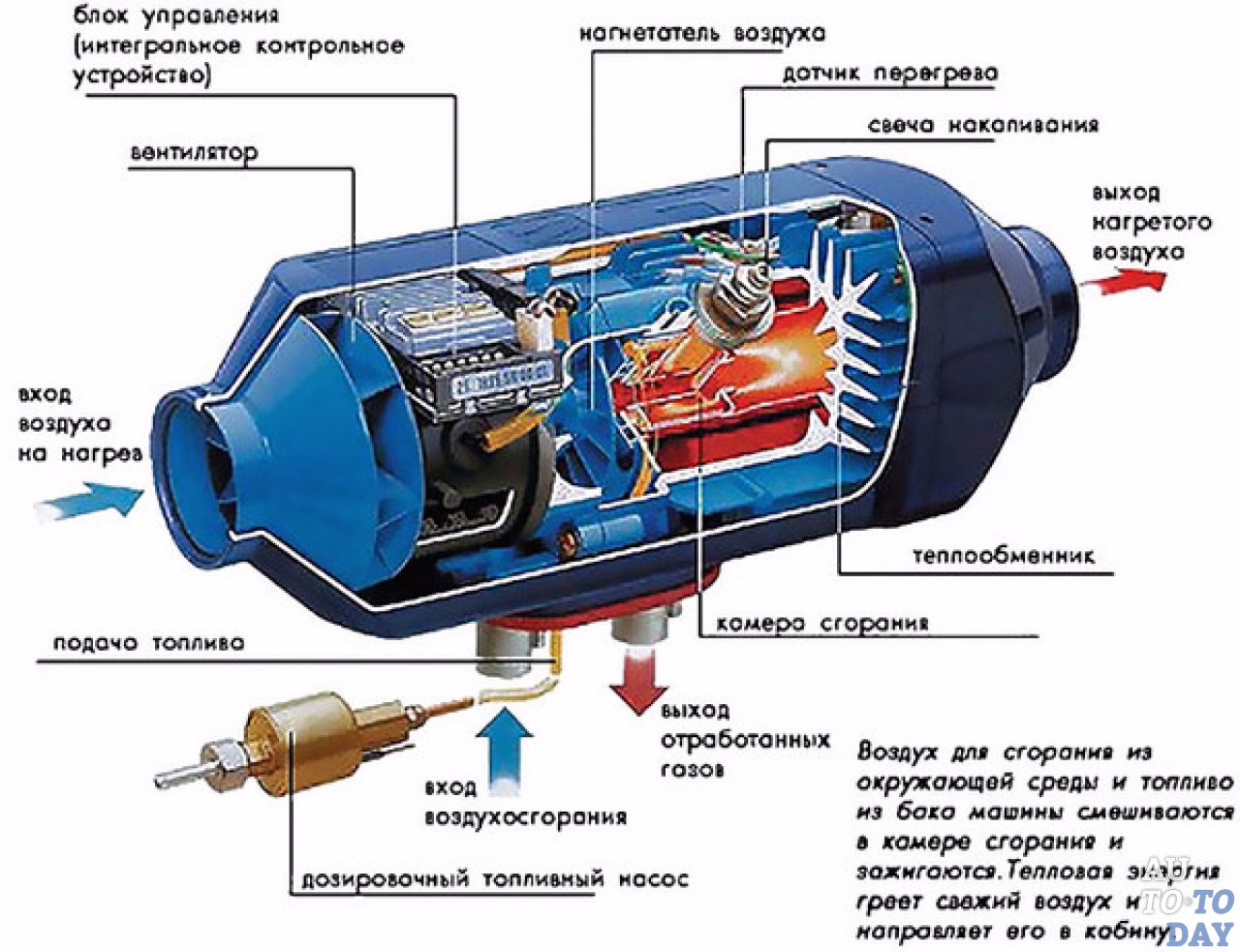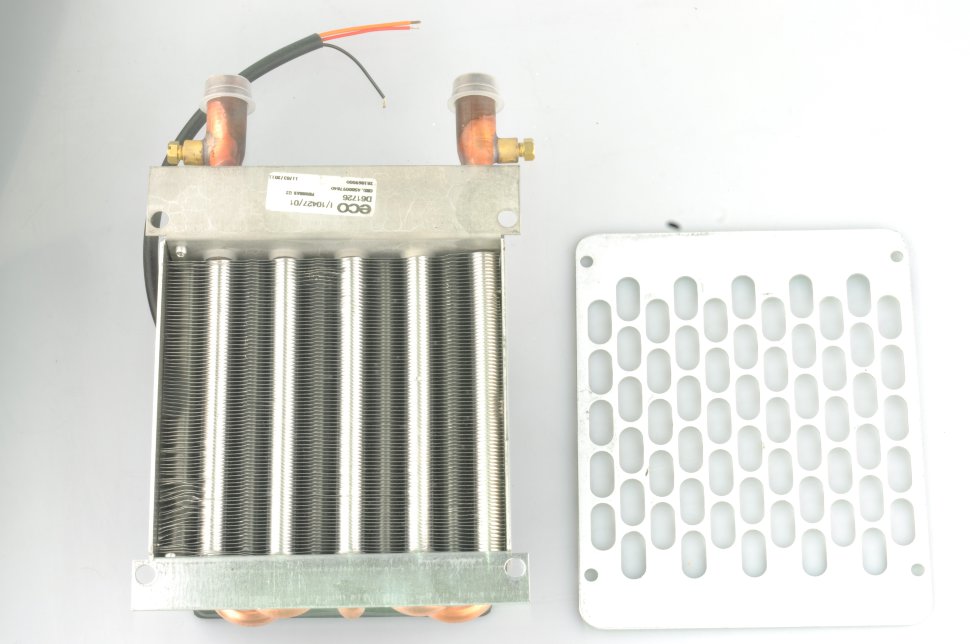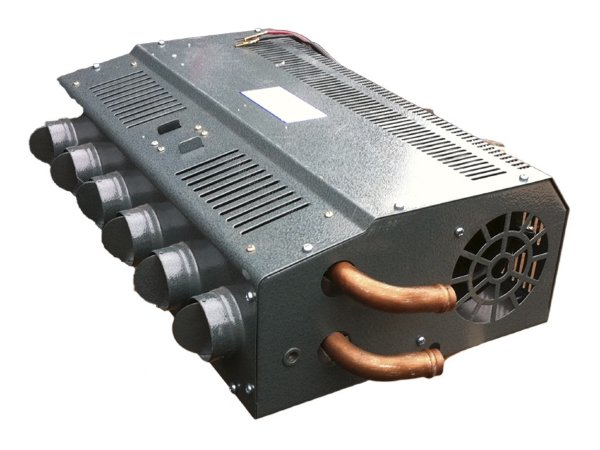
Additional heater in the car: what is it, why is it needed, the device, how it works
Content
An additional interior heater is a unit that is connected in a set with equipment installed by the vehicle manufacturer. It is able to minimize the wear of the car mechanisms at the time of starting the engine, as well as maintain comfortable conditions for the driver and passengers while traveling in the autumn-winter period.
The auxiliary heater of the car interior is a universal unit, the main function of which is to quickly heat the air in the cabin to maintain the comfort of the driver and passengers. Autonomous equipment allows you to quickly restore a comfortable temperature inside the car after long periods of parking in the cold season, as well as minimize glass fogging to improve visibility and prevent possible accidents. Consider the types and characteristics of auxiliary heaters, experts' recommendations on the selection and operation of units.
What is an additional heater in a car
A long stay of the car outside the garage box in the cold season contributes to the formation of the thinnest ice crust on the inside of the glass and the thorough freezing of individual structural elements. These processes are most intense at night - a sad consequence will be a significant decrease in the temperature in the cabin and the impossibility of quickly starting the engine for a trip on business or to work.
In such a situation, an additional car interior heater can help out - a unit that is connected complete with equipment installed by the vehicle manufacturer. Such a heater is able to minimize the wear of the machine mechanisms at the time of starting the engine, as well as maintain comfortable conditions for the driver and passengers while traveling in the autumn-winter period.
Appointment of equipment
The main area of application of universal car heaters is the implementation of passenger and freight transportation using buses, vans, minivans and minibuses.

A minibus is the ideal vehicle for installing an autonomous heater
If there is enough free space, such a unit can be placed in a passenger car for everyday use, however, safety precautions should be observed and the generator's capabilities should be correctly assessed to generate a sufficient amount of power.
Heater device
The basis of any unit for warming up a car is a radiator, complemented by coolant circulation pipes, dampers, a flow force regulator, a fan and an air duct. Liquid-based equipment is not the only option available to drivers; there are modifications powered by the mains on the market, as well as air heaters that differ in design and method of heating.
Principle of operation
Maintaining a comfortable temperature in the car interior by means of autonomous car ovens is carried out in several ways, which differ depending on the design features of a particular unit. For example, electrical devices use a 220 V household network to heat the antifreeze in the internal tank and then pump it into the standard heating system, while liquid units heat the antifreeze circulating through the car's oven radiator. A detailed description of the principles of operation of each of the types is presented in the following sections of the article.
Types of car interior heaters
There are many modifications of autonomous systems on the market to maintain the optimum temperature in the car, differing in principle of operation, cost and power output. The most popular among drivers of heavy trucks and minibuses are heaters operating on the basis of coolant, household electricity and heating the air in the cabin using fuel or heating elements.
Autonomous
Car heaters that do not require a permanent connection to the household electrical network are very popular with drivers of trucks, minibuses and minivans - the unit is located outside the cab or in the free space under the hood. The principle of operation of autonomous equipment of this type is extremely simple - the auxiliary accessory for heating the passenger compartment is powered by fuel burned in the inner chamber, and the exhaust system integrated into the design removes combustion products into the environment.
Air heater for car
Another widespread method of warming up the passenger compartment in autumn or winter is to install an auxiliary radiator to the standard factory stove, which allows you to blow warm air into the passenger compartments using a fan. Such an idea requires the placement of a system of additional nozzles and is successfully applied in practice in buses, minibuses and cargo vans with impressive interior dimensions.
Such structures are of two types:
- The so-called "hair dryers", where the air is heated by a ceramic heating element, which excludes the "burning" of air inside the cabin. The principle of operation of this type of heater is similar to a standard household hair dryer - the accessory is connected through a standard 12-volt cigarette lighter socket.The main disadvantage of the device is its low power, which does not exceed 200 W, and allows only the space near the driver or the windshield to be heated after a long overnight stay.
- Heaters running on diesel fuel or gasoline. The design of such units is made in the form of a cylinder, the energy for spinning the fan and supplying heated air to the passenger compartment is generated by ignition with a candle and combustion of fuel in the inner chamber.
Air circulation heaters are mainly used in buses with a spacious interior or heavy trucks during long periods of parking in the open air. The use of such a unit allows the owner of the vehicle to save a significant amount of fuel in comparison with the engine turned on during idle time to maintain comfortable conditions in the driver's cab.
Additional benefits of these accessories:
- ease of placement and operation;
- high efficiency with a minimum level of energy spent.
Air heaters are also characterized by certain negative properties:
- the design reduces the amount of free space in the driver's cab;
- air intake requires the placement of auxiliary pipes;
- the use of the unit allows you to warm up only the interior of the vehicle.
Liquid interior heater
Units operating on the basis of antifreeze or other types of cooling substances are characterized by the highest efficiency and are mounted in a standard car factory heating system. The main locations for placing an accessory in the form of a special block with a fan and a combustion chamber are the engine compartment or interior space; in some situations, the design is supplemented by an auxiliary pump to pressurize the circulating fluid.
The principle of operation of such an additional car interior heater is based on heating the antifreeze concentrated in the stove radiator, fans are used to blow the space inside the cabin and supply heat directly to the motor. The combustion process in such a unit occurs due to the supply of air, an increase in heat transfer is achieved due to the auxiliary flame tube, and the exhaust gases are removed using a pipe located under the bottom of the vehicle.

An example of a model of a liquid autonomous heater is a Russian-made unit "Helios-2000"
The main advantages of devices of this kind:
- significant space savings in the cabin due to the possibility of mounting under the hood;
- increased efficiency;
- significant energy savings.
The main disadvantages of liquid heaters are:
- devices are the most expensive in comparison with other types of autonomous heaters on the market;
- increased installation complexity.
Электрический
Devices of this type are connected to the vehicle's factory heating system and operate on the basis of a 220 V household electrical network. The principle of operation of the electric unit determines its main advantage - the driver does not need to spend fuel or antifreeze to achieve the optimum temperature in the cabin in comparison with the operation of air or liquid heaters.

The use of autonomous electric heaters contributes to significant fuel and financial savings
The main disadvantage of such a unit is the need for access to an electrical outlet for work, which cannot always be met in a timely manner during a long journey by bus or truck. An additional difficulty for the driver will be the independent connection of the equipment to the standard heating system - to solve this problem, auto experts recommend contacting specialized service centers.
Popular manufacturers of car heaters
On the Russian market there are several lines of air heaters (the so-called "dry hair dryers"), differing in power, country of origin and cost. The most popular among truckers are the following time-tested brands:
- German heaters Eberspacher and Webasto of the premium price segment;
- budget domestic units "Planar" from the Samara company "Advers";
- mid-price Chinese Belief devices.

Autonomous heaters from the Russian manufacturer Planar are very popular among car owners
How to choose a heater for a car
When purchasing a good heater for use in a minibus or truck, the driver is first of all advised to pay attention to the power of the device. There are 3 main categories of heaters on the market:
- two-kilowatt - used in compact cabins;
- three-four kilowatts - suitable for use in most cabins of dump trucks, minibuses and long-range trucks;
- five-eight kilowatt - used to warm up motorhomes and KUNG-type bodies.

In heavy trucks, autonomous heaters with a capacity of over 3 kilowatts are used.
Additional factors to consider when choosing an efficient unit:
- the possibility of remote control;
- availability of free space for mounting the structure;
- fuel consumption and volume of heated air, weight and dimensions of the accessory.
Detailed technical characteristics are usually indicated in the product cards on the website of the manufacturer or the seller, where you can order the best heater option with delivery anywhere in the country in a couple of clicks.
How to use
Despite the apparent simplicity of design, an additional heater is a complex unit that requires the driver to comply with certain rules during operation. Auto experts recommend following these guidelines:
- activate the device at least once a month to bleed the fuel system and clean it from dust particles and combustion products;
- eliminate the possibility of accidentally turning on a car accessory during refueling;
- turn off the heater at the end of the movement to prevent battery discharge.
What can replace the stove in the car
On thematic forums of motorists on the network, you can find step-by-step guides for self-assembly of autonomous heaters from improvised materials. One of the popular options in this case is a design based on the case of a system unit from a desktop computer, complemented by filaments and a compact fan used to cool the processor or motherboard.
The performance and safety of home-made heating units raises big questions, so auto experts do not recommend ordinary drivers without the proper level of technical knowledge to experiment with the creation and connection of such devices. Installation of an additional car heater must be carried out by a service center specialist in order to avoid emergency situations or accidents during travel.

